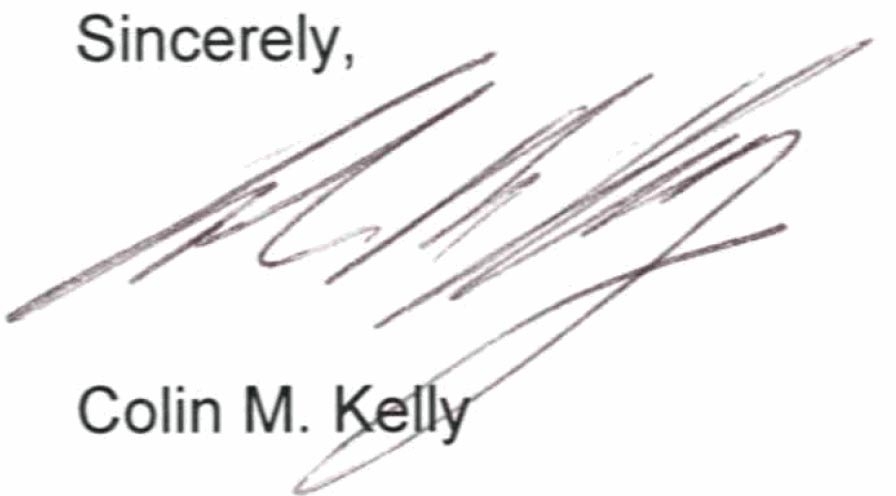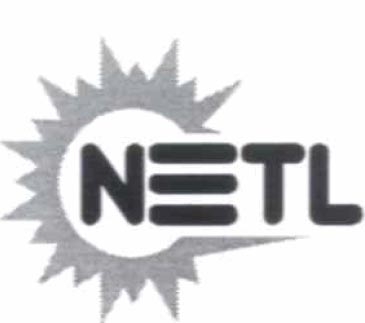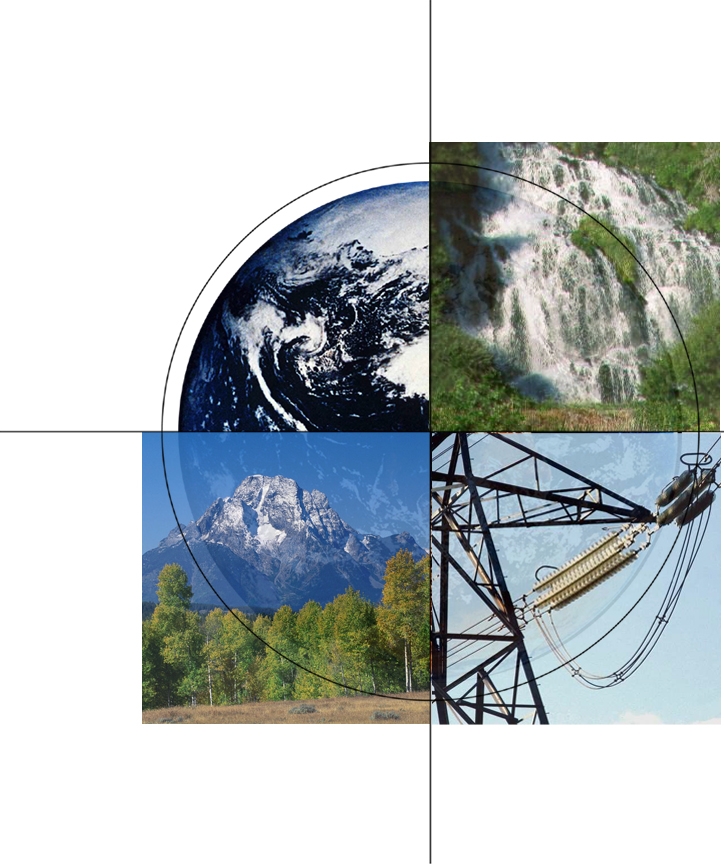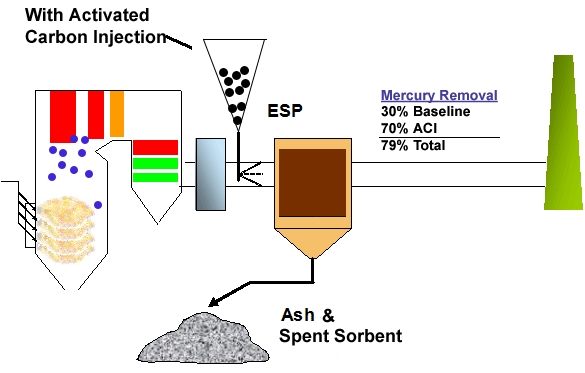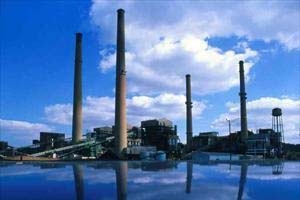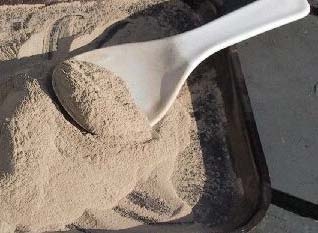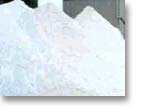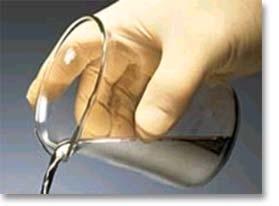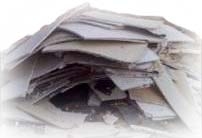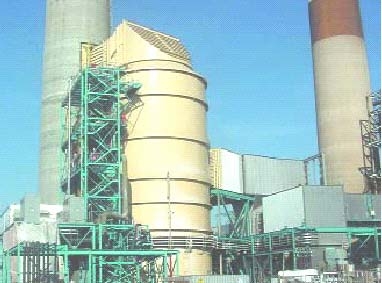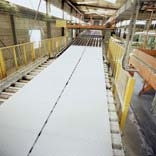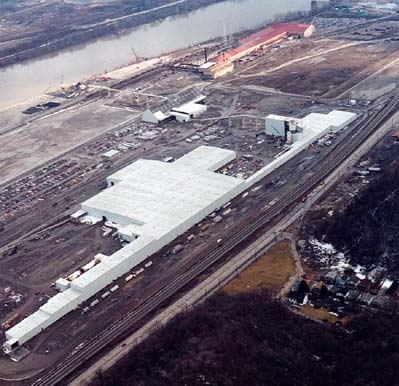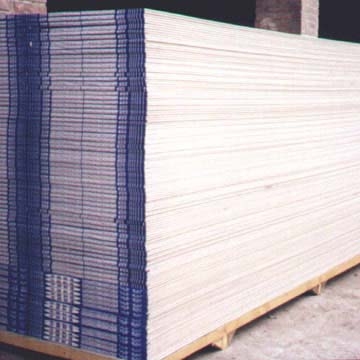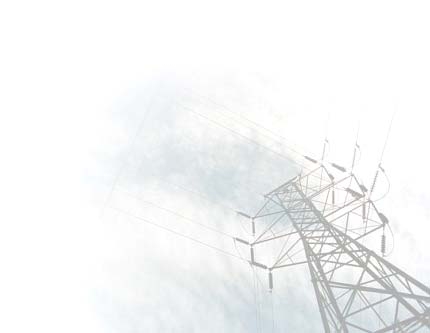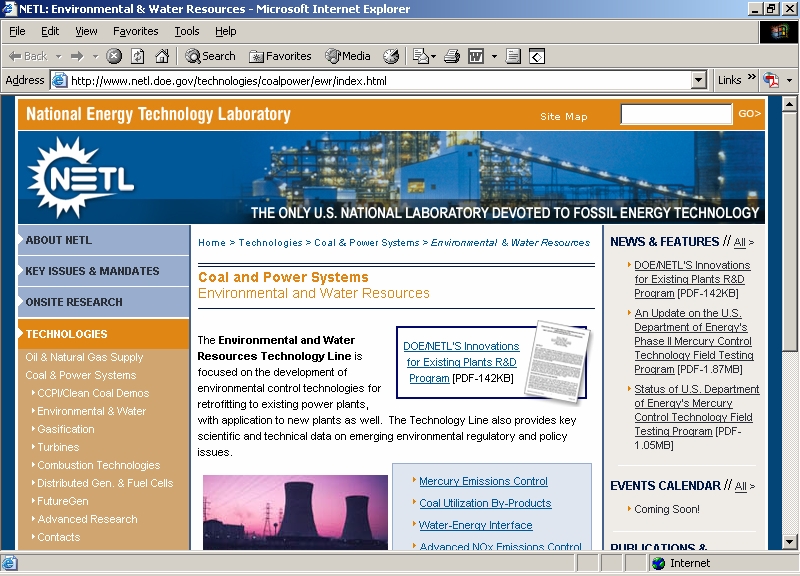| | - BEFORE THE ILLINOIS POLLUTION CONTROL BOARD
- NOTICE OF FILING
- SEE ATTACHED SERVICE LIST
- BEFORE THE ILLINOIS POLLUTION CONTROL BOARD
- APPEARANCE
- BEFORE THE ILLINOIS POLLUTION CONTROL BOARD
- TESTIMONY OF DIANNA TICKNER
- Specific Comments
- Ms. Laurel Kroack March 13,2006 Page 8
- Enclosure
- cc: Douglas P. Scott
- a~oroved by the Aeencv.)
- National Energy Tecbnohgy Laboratory
- Development Status of Mercury-Specific Control Technology
- Cost of Activated Carbon Injection
- Impacts of Mercury Control on Cost of Electricity
- U.S. DOE’s Hg Control Technology RD&D Program—
- Significant Progress, But More Work to be Done!
- Outline
- Mercury Control Technology Program
- Baseline (1999) Costs: $60,000 / lb Hg Removed
- 2000 Year
- NETL’s Hg Control Technology R&D
- rank coals more difficult to control due to lower Cl/higher element Hg content
- treated (e.g., halogenated) activated carbon (AC)
- Balance-of-Plant Issues/Lessons Learned
- TOXECON Retrofit for Hg and Multi-Pollutant Control
- Problem with Overheating Powdered Activated
- Carbon at Presque Isle
- all hoppers had embers
- heaters
- (welding, cutting, hopper heaters)
- Mercury Control Options for TXU’s
- Big Brown
- Side B ~ 300 MWSide B ~ 300 MW
- FF4 ~ 150 MWFF4 ~ 150 MW
- Upcoming NETL Field-Testing
- at Bituminous Units
- Quarter 2006ApproachLee Unit 3conditioning
- Gavin Station CS-ESP / Wet FGD Unknown TOXECON™ II 3.76
- Portland Unit 1 CS-ESP March 2006 Mer-Cure™ 2.01
- Conesville Unit 6 CS-ESP / Wet FGD March 2006 Enhanced ACI 3.00
- Amended 2.21Miami Fort Unit 6 CS-ESP 1stQuarter 2006Silicates™
- Lee Unit 1 CS-ESP November 2005 Enhanced ACI 0.77
- Yates Unit 1 CS-ESP / Wet FGD Fall 2005 Wet FGD additive 0.93
- Yates Unit 1 CS-ESP / Wet FGD November 2005 MerCAP™ 0.93
- Oxidation 0.93Yates Unit 1 CS-ESP / Wet FGD September 2005Catalysts
- Coal Sulfur Content (wt%)
- Mercury APCD Start DateControlConfiguration
- Bituminous
- Preliminary Results of Field Testing at Conesville
- Power Plant – Impact of High-S Coal
- (3.5-4%) bituminous coal equipped with ESP and wet FGD
- activated C yielded only 5-31%
- Hg removal @ 9-18 lb/MMacf
- on AC or otherwise compromise AC Hg removal capabilities
- DOE Hg Control RD&D Timeline in Sync with the
- Clean Air Mercury Rule (CAMR)
- DOE initiated field testing
- of technologies that
- mercury capture in
- early 2006
- 2005 2010 2018
- Complete field
- testing
- of technology
- capable
- of 50-70% Hg
- capture
- CAMR Phase I38 ton/year capvia Co-Benefit (NOx & SO2)
- Controls
- Issued
- CAMR Phase II15 ton/year capvia Hg Specific
- Controls
- Complete field
- testing
- of technology
- capable
- of 90%+ Hg capture
- Full-scale commercial
- demonstrations
- Commercial deployment
- Phase II Field Testing Economic Analysis
- Incremental Cost of 70% ACI Mercury Control
- Stanton #10
- Incremental Cost of Control,
- $/lb Hg Removed
- $10,000
- $20,000
- $30,000
- $40,000
- $50,000
- $60,000
- $70,000
- DOE 2007 Goal: ~$45,000/lb Hg Removed
- St. Clair
- Key Challenges to Continued/Increased
- By-Product Use
- meet CAIR (SO2) will increase volume
- of scrubber solids
- could negatively impact fly ash utilization due to increased carbon content
- from flue gas to fly ash and scrubber solids
- Fly Ash FGD By-product
- Mercury
- Projection of U.S. Coal-Fired Power Plant
- CUB Production
- Flyash Production
- FGD Solids Production
- 2004 2020
- Million Tons
- Coal-fired power generation projected to increase from
- 1,916 to 2,405 billion kWh from 2004 to 2020
- FGD capacity projected to increase from
- 100 to 231 GW from 2004 to 2020
- Wallboard Plant
- Wallboard production
- Home Construction
- Wallboard disposal
- Wallboard
- Wet FGD Scrubber
- FGD Gypsum Disposal
- FGD Gypsum:
- Pathways for Potential Mercury Release
- Incremental Cost of 70% ACI Mercury Control
- Stanton #10
- Incremental Cost of Control,
- $/lb Hg Removed
- $25,000
- $50,000
- $75,000
- $100,000
- $125,000
- $150,000
- DOE 2007 Goal: ~$45,000/lb Hg Removed
- Key Takeaways from Field Testing
- under “no by-product impact” scenario
- remain a “wild card”
- DOE/NETL Environmental and Water Resources
- (Innovations for Existing Plants Program)
- Re: Prairie State Energy Campus Hitachi Response (Hg 90% Removal)
- CERTIFICATE OF SERVICE
- SERVICE LIST
- (R06-25)
- SERVICE LIST
- (R06-25)
|
BEFORE THE ILLINOIS POLLUTION CONTROL BOARD
IN THE MATTER OF:
)
)
R06-25
PROPOSED NEW 35 ILL. ADM. CODE 225
)
(Rulemaking – Air)
CONTROL OF EMISSIONS FROM
)
LARGE COMBUSTION SOURCES (MERCURY)
)
NOTICE OF FILING
TO:
Dorothy Gunn
Gina Roccaforte, Assistant Counsel
Clerk
Charles E. Matoesian, Assistant Counsel
Illinois Pollution Control Board
John J. Kim, Managing Attorney
James R. Thompson Center
Air Regulatory Unit,
100 W. Randolph St. , Suite 11-500
Division of Legal Counsel
Chicago, Illinois 60601-3218
Illinois Environmental Protection Agency
1021 North Grand Avenue, East
Marie E. Tipsord
P.O. Box 19726
Hearing Officer
Springfield, Illinois 62794-9276
Illinois Pollution Control Board
john.kim@epa.state.il.us
James R. Thompson Center
charles.matoesian@epa.state.il.us
100 W. Randolph, 100 W. Randolph
gina.roccaforte@epa.state.il.us
Chicago, Illinois 60601-3218
tipsorm@ipcb.state.il.us
SEE ATTACHED SERVICE LIST
PLEASE TAKE NOTICE that on July 28, 2006, I the undersigned caused to be
filed electronically with the Clerk of the Illinois Pollution Control Board the
APPEARANCE of Mary Frontczak on behalf of Prairie State Generating Company, LLC
and the attached TESTIMONY OF DIANNA TICKNER, copies of which are herewith
served upon you.
By:___[s]_Mary_Frontczak________________
Mary Frontczak (Reg. No. 6209264)
DATED: July 28, 2006
ELECTRONIC FILING, RECEIVED, CLERK'S OFFICE, JULY 28, 2006
Mary Frontczak
Peabody Energy
701 Market Street
St. Louis, Missouri 63101-1826
(314) 342-7810
ELECTRONIC FILING, RECEIVED, CLERK'S OFFICE, JULY 28, 2006
BEFORE THE ILLINOIS POLLUTION CONTROL BOARD
IN THE MATTER OF:
)
)
R06-25
PROPOSED NEW 35 ILL. ADM. CODE 225
)
(Rulemaking – Air)
CONTROL OF EMISSIONS FROM
)
LARGE COMBUSTION SOURCES (MERCURY)
)
APPEARANCE
I hereby file my appearance in this proceeding on behalf of Prairie State
Generating Company, LLC.
_[s]_Mary_Frontczak__________________
Mary Frontczak
Reg. No. 6209264
Peabody Energy
701 Market Street
St. Louis, Missouri
(314) 342-7810
DATED: July 28, 2006
ELECTRONIC FILING, RECEIVED, CLERK'S OFFICE, JULY 28, 2006
BEFORE THE ILLINOIS POLLUTION CONTROL BOARD
IN THE MATTER OF:
)
)
R06-25
PROPOSED NEW 35 ILL. ADM. CODE 225
)
(Rulemaking – Air)
CONTROL OF EMISSIONS FROM
)
LARGE COMBUSTION SOURCES (MERCURY)
)
TESTIMONY OF DIANNA TICKNER
My name is Dianna Tickner. I am a Vice President of Prairie State Generating
Station, LLC (“Prairie State”) and I am here today to testify on its behalf. Prairie State is
directly affected by the proposed rule as it intends to construct a new 1500 megawatt
pulverized coal electric generating unit (“EGU”) facility in Washington County, Illinois.
The facility, Prairie State Generating Station, is being designed to burn high-sulfur
Illinois coal. In addition to my testimony, Prairie State will be providing detailed written
comments on the proposed rule.
Prairie State submitted comments to the Illinois Environmental Protection Agency
on the proposed rule on March 13, 2006. Those comments with minor corrections are
incorporated herein as part of my testimony (Attachment 1). As indicated in those
comments, Prairie State recommends that Illinois adopt the federal Clean Air Mercury
Rule (“CAMR”) as promulgated by the United States Environmental Protection Agency.
Prairie State has significant reservations on going beyond CAMR, which will be
elaborated on in the written comments. Specific to the Illinois proposed rule, Prairie
State expressed general concerns with the feasibility of 90% mercury removal efficiency
including the lack of any meaningful guarantees; the method for demonstrating
compliance with the 12-month rolling average standard, and the monitoring requirements.
Prairie State also identified concerns with specific provisions of the proposed rule.
ELECTRONIC FILING, RECEIVED, CLERK'S OFFICE, JULY 28, 2006
Prairie State also reviewed the Temporary Technology Based Standard (“TTBS”)
and provided comments to the Illinois Environmental Protection Agency on June 1, 2006.
Those comments were previously admitted as Exhibit 61 and are incorporated herein as
part of my testimony (Attachment 2). Prairie State believes the TTBS is a necessary
addition to the proposed rule to address any shortfalls in the capabilities of the
technologies. As expressed in the comments, Prairie State does have some concerns with
the current proposal, particularly for new generation.
In addition to the comments previously submitted, Prairie State is still concerned
about the long-term capabilities of the available technologies to control mercury
emissions from EGU flue gas. While there has been considerable testimony to date about
the capabilities of the available technologies (
see e.g.,
testimony of Dr. Staudt and Mr.
Nelson), that testimony appears to be based on several short term studies at facilities
burning low to medium sulfur coal. Mr. Nelson did identify one study that is currently
ongoing on a higher sulfur coal at Conesville Unit 6. As shown in Attachment 3, for coal
sulfur content of 3.5% to 4% the preliminary results indicate a mercury removal
efficiency of less than 20%. That removal efficiency is nowhere near the percent
removal that would be required to comply with the proposed rule. As discussed in our
March 13, 2006 comments, Prairie State to date has been unable to obtain a guarantee for
90% mercury removal on its high sulfur coal.
See
Attachment 4. Additionally, as the
studies have been short-term, there is no long-term information on the effect the available
technologies will have on balance of plant operations. Further study to assess high-sulfur
coals and the impact on plant operations is needed before imposing requirements that are
more stringent than CAMR.
ELECTRONIC FILING, RECEIVED, CLERK'S OFFICE, JULY 28, 2006
ATTACHMENT 1
TO
TESTIMONY OF DIANNA TICKNER
ELECTRONIC FILING, RECEIVED, CLERK'S OFFICE, JULY 28, 2006
March 13,2006
Via Electronic Mail and Federal Express
Ms. Laurel Kroack
Bureau of Air
Illinois Environmental Protection Agency
1021 North Grand Ave. East
Post
Office Box 19276
Springfield,
l llinois 62794-9276
Re:
Comments on Draft Regulations for Control of Mercury Emissions
from
CoaCFired Electric Generating Units
Dear Laurel:
Prairie State Generating Company LLC is pleased to provide these comments on the
draft proposed regulations for Control of Mercury Emissions from Coal
-Fired Electric
Generating Units to be incorporated in 35 IAC 225. Prairie State
will be directly affected
by these regulations as
it is planning to construct a new coal-fired power plant in Illinois.
Provided below are our general observations and comments on the draft proposed
regulations followed by comments on specific provisions. In addition we are providing
suggested revisions and additions to the proposed regulations to address our concems.
General Observations and Comments
In general, Prairie State recommends that Illinois adopt regulations that are consistent
with the Clean Air Mercury Rule (
"CAMR
n
) promulgated by the United States
Environmental Protection Agency (
"EPA"). As to the draft regulations proposed, Prairie
State has three general concerns: (1) the
feasibilrty of 90% mercury removal efficiency;
(2) method for demonstrating compliance with the 12
-month rolling average standard;
and
(3) monitoring requirements.
MRIE STATE QEUaR1TIUO
-,
1U:
701 Market Street, Suite 781
St. his, Missouri 631
01
-1826
As will be explained in detail below, the requirement of a 90% removal efficiency is
beyond what has been proven in field studies to date. While Prairie State believes that
technology available in the future may be capable of controlling emissions at that
efficiency, such technology has not yet matured to the level that vendors are willing to
provide guarantees.
As
such the current proposed draft regulations could impair Prairie
ELECTRONIC FILING, RECEIVED, CLERK'S OFFICE, JULY 28, 2006
Ms. Laurel Kroack
March 13,2006
Page
2
State's ability to finance and construct the facillty. Consequently, Prairie State has
proposed language that it believes meets the needs of all parties.
A
Reauirement of 90% Reduction is Not Feasible
As drafted, the regulations would require a 90% reduction in mercury emissions by
2009. This requirement appears to be based on a draft report titled
17echnology for
Controlling Mercury Emissions from Coal
-Fired Power Plants in Illinois
n
("Draft Mercury
Repor), which has been posted on the IEPA website. For the reasons set forth below
and in the enclosure to this letter, Prairie State believes that this requirement is not
technologically feasible or commercially feasible.
The
majonty of the Draft Mercury Report is a fair and balanced discussion of mercury
control. Where the Draft Mercury Report strays from basic scientific principles is when
it
optimistically predicts that a wide variety of control configurations can achieve 90%
mercury control. These claims rest on limited testing where 90% control was
occasionallv achieved. On close inspection of the performance during the tests, one
can make the case that 80
-85% control is achievable, but not 90%. Establishing the
standard at 90% would provide no margin of error and assumes continual operation at
the best (but unproven) control removal efficiency. That virtually assures non
-
compliance will occur.
In order for a
facillty to continuously comply with a 90% mercury control requirement, it
will normally need to operate at control levels around 95%. This margin is needed in
order to account for the routine variability in emissions regardless of how well controlled
a facility is. This higher control rate is needed to address excess emissions that occur
during
malfunctions, and process upsets. In developing CAMR, EPA evaluated
technological capabilities and determined that 90% was not feasible at this time.
Specifically, in discussing the use of activated sorbent injection in conjunction with
conventional technologies to achieve 90 percent or greater mercury removal, EPA
stated:
Although EPA is optimistic that such controls may be
available for use on some scale prior to 2018,
it does not
believe that such controls can be installed and operated on a
national scale before that date. Based on tests, ongoing
studies and discussions, we do not believe that the Hg
-
specific technologies have demonstrated an ability to
consistently reduce Hg emissions by 90 percent (or any
other level) at the present time.
70 Fed. Reg. 28606,2861 5 (May
18,2005).
ELECTRONIC FILING, RECEIVED, CLERK'S OFFICE, JULY 28, 2006
Ms. Laurel Kroack
March 13,2006
Page
3
The Draft Mercury Report also overstates the long-term nature of the testing that has
occurred to date. In fact virtually all of the tests cited in the Draft Mercury Report have
been one month or less. It does not answer the question: what can these technologies
produce over the long term? Short term testing of technology does not mean
it will
perform at the levels observed during those tests over the long
-term or that the
technology is commercially available in any true sense. Nor does
it resolve all concerns
about balance
-of-plant effects. For example, the Draft Mercury Report tries to sweep
aside the greatest concern about brominated activated carbon injection
('ACI") -
namely whether it will cause corrosion or other maintenance and availability problems
over the long term. The Environmental Appeals Board recently reiterated that short
-
term data may not be suffi~cient
to be the basis for a limit that has to be achieved over
the long
-term.
See In
re
Newmont Nevada Energy Investment,
L. L.C., PSD Appeal No.
05
-04 (EAB Dec. 21,2005).
Finally, the Draft Mercury Report's discussion of vendor guarantees appears to have
been taken directly from the vendor's literature. The discussion is very misleading and
implies meaningful guarantees are readily available, which is not true. Prairie State has
not been able to obtain a 90% mercury control guarantee even though the project
includes an SCR and a wet FGD.
Of note, the Draft Mercury Report indicates that such
a technology configuration should easily be able to remove 90% of the mercury from
bituminous coal.
Id.
at 36. The Draft Mercury Report also states the
"liabillty to the
vendor
. . . .is related to the cost of the project."
Id.
at 30. In most cases the cost of the
"projectn
will be the cost of the sorbent injection system, which is in the $ 1 to 3 million
range per unit. This vendor
liabillty limit is typically much less than the costs the
Owner's
will experience if the mercury control guarantees are not met, including
shutting down a
facillty resulting in direct consequences of lost jobs and economic
benefit to the area as well as the indirect consequence of increased energy costs to
consumers. Moreover, the vendors generally are smaller companies that do not have
the financial wherewithal to ever make good on their extremely limited guarantees. In
essence, vendors are guaranteeing that
if their mercury controls don't work they will
give you another one just like
it. This doesn't help a power plant that is out of
compliance with a state regulation.
For more details on the concerns raised by the Draft Mercury Report, see the enclosed
letter from Steve Bjorklun of Bums and
McDonnell (March 10,2006). Given the above,
it is arbitrary for Illinois to include a 90% reduction requirement by 2009. Prairie State
believes that the Department of Energy ('DOE
n
) concurs with its position that the
technology is not yet mature. DOE has initiated twelve long
-term studies (12 to 36
months) to evaluate the viability of new and existing technologies with various coals.
DOE'S
goal is to have these technologies ready for commercial demonstration by 201 0,
which is after Illinois' proposed regulation would go into effect. Prairie State
ELECTRONIC FILING, RECEIVED, CLERK'S OFFICE, JULY 28, 2006
Ms. Laurel Kroack
March 13,2006
Page
4
recommends that Illinois follow this effort and include a provision in the regulations to
incorporate
DOE's results. Regulations should not be based on predictions of what can
be achieved in the future as is the case here. They should be based on what has
actually been achieved and technology that is demonstrated and commercially feasible.
Discussions with vendors, lenders and equity participants in the project indicate that,
without an established, proven technology combined with suitable guarantees, the
project may have to be delayed or possibly not built at all. To address the fact that the
technology is not proven and vendors are unwilling to offer a viable guarantee that 90%
can
be achieved at all times or for the life of the facility, Prairie State is proposing the
following language to
be added as a new provision to 5225.237 to meet the needs of all
parties:
If a new EGU installs technology, at a minimum a particulate
matter collection device, a flue gas
desutfurization unit, a
selective catalytic reduction device, and
sorbent injection
(other material or combination of materials), and due to
technical shortfalls of such equipment, processes, or
systems is unable to achieve the emissions standards as set
forth in this regulation, the
EGU ownerloperator shall pursue
a corrective action plan in conjunction with the Illinois EPA to
determine alternative emissions standards for the EGU.
Such corrective action plan shall include a requirement to
determine the maximum practicable degree of mercury
removal that can
be continuously achieved with the installed
technology. During the pendency of the correction action
plan and the establishment of a site
-specific mercury
standard, the EGU
will be deemed in compliance with the
requirements of this regulation.
If Illinois is correct that 90% removal is continuously achievable, the above provision
would never need to
be implemented. Prairie State, however, believes that 90% is not
continuously achievable (for the reasons explained above and in Mr.
Bjorklun's letter)
and thus the provision is necessary. Absent such a provision, well
-controlled sources
unable to achieve the standard would be in a perpetual state of noncompliance or be
forced to shut down, leaving a significant void in the generation of needed power. Such
a provision would also bridge the gap pending the outcome of
DOE's studies.
Method of Assessing Compliance Could Lead to Anomalous Results
Assessing compliance over a 12
-month period as proposed is helpful, particularly given
the large variability in mercury emissions. Illinois' proposal to assess compliance on a
ELECTRONIC FILING, RECEIVED, CLERK'S OFFICE, JULY 28, 2006
Ms. Laurel Kroack
March 13,2006
Page
5
monthly basis and then average those 12 months to determine compliance appears to
be based on the trading program established by EPA, which is not relevant to Illinois'
proposal.
It would be simpler to require plants to use the prior year of data to
demonstrate compliance with the limits, a true rolling annual limit. Such an approach
would avoid the adverse effects of anomalous months
(i.e., a few days of operation at
higher than normal mercury levels) and would not result in a finding of
non-compliance
for an entire month if a 12-month rolling average exceeded the mercury limits [see draft
§ 225.1301. Thus, Prairie State would suggest that a plant be required to report only its
twelve month rolling average based on the previous years worth of data.
Monitorina Reauirements Should be Consistent with CAMR
Currently, there are many questions about EPA's mercury monitoring requirements and
whether
CEMs will accurately measure mercury emissions under all conditions. EPA's
mercury monitoring requirements are currently being challenged in the D.C. Circuit. It
remains to be seen whether that challenge
will lead to revisions to EPA's monitoring
requirements but
it is highly likely that some changes will be made by EPA. The
question then arises: Does Illinois plan to revise its mercury monitoring requirements
if
EPA revises its regulations? The draft regulations incorporate some EPA requirements
by reference but they also include some specific mercury monitoring requirements.
Prairie State recommends that lllinois simply incorporate the EPA's monitoring
requirements by reference. This will avoid a situation where monitoring requirements in
Illinois are inconsistent with the remainder of the country leading to the potential
unavailability of monitors for facilities in lllinois.
Additionally, there are potential concerns with the methods (coal sampling as proposed,
or monitoring of inlet to control technology) for demonstrating compliance with the
percent removal standard. There is limited data available to confirm that these methods
would provide a consistent reliable measure of percent removal.
Specific Comments
Below are Prairie State's comments on specific provisions in the draft proposed
regulations.
5 225.130
-
definition of "electric generating unit":
An EGU is defined to include
"fossil fuel-fired" boilers and combustion turbines. Since EPA decided only to regulate
mercury emissions from coal
-fired units, wh the more inclusive definPnn9 Yote that
applies to coal-fired units
kRECTION
-
Dirregam
rn~
of electric generating unit is not in
the
proposed rule.]
ELECTRONIC FILING, RECEIVED, CLERK'S OFFICE, JULY 28, 2006
Ms. Laurel Kroack
March 13,2006
Page 6
f 225.130
-
definition of "rolling 12month basis":
The definition implies that a 12-
month average is calculated based on monthly averages. The definition excludes
months when a boiler never operates. It presumably includes months when the boiler
operates as little as one day. This can lead to anomalous results. As noted above, a
better way to smooth results
would be to look at all data for the prior 12 months and
then calculate the average emission rate or percentage reduction making it a true
annual average. Emissions during periods of startup and shutdown should also be
excluded as technologies, such as SCR which aid in mercury removal, are not
operational during those periods. Such an exclusion would be consistent with the
NSPS.
f 225.140 and 225.202
- Standard Lab uses ASTM D6722-01 "Standard Test Method
for Total Mercury in Coal and Combustion Residues by Direct Combustion Analysis
" to
determine Mercury in coal for Draft Mercury Reporting under the MACT rule and other
Draft Mercury Reporting. The draft proposed regulations does not list ASTM D6722
-01
as an acceptable method. However, ASTM has obtained EPA acceptance of ASTM
D6722-01 as equivalent to all other required Mercury Determination methods. Per
ASTM, this acceptance is so stated in the Federal Register Volume 70 Number 209
(October 31,2005) (40 C.F.R. Part 63). This draft needs to include ASTM D6722
-01 as
an acceptable method.
f 225.210(e)
- Compliance should be judged at the source, not the unit level. If each
EGU must meet the stack limit, then
it follows that the source should be in compliance.
By requiring both the unit and source to
be in compliance, Illinois is effectively
assessing two violations if a unit fails to meet the emission limit.
f 225.220(~)(1)
- It is unclear what mercury requirements Illinois considers to be
"federally enforceable." Illinois' requirements go far beyond CAMR and as a result are
state standards, not federally enforceable limits.
f 225.230
- Given the definition of a 'rolling 12-month basis" there appears to be no
difference between compliance options (a) and (b).
5 225.230 (d)(3)
- This results in multiple violations when it may be only one unit that
has compliance issues.
f 225.232
- Averaging provisions appear to apply only to "existing" units. "New" units
should also have averaging provisions since the stringency of the limits Illinois proposes
to impose on new units is the same as existing units
- 90% control?
5 225.237
- The limits on new sources go beyond EPA's § 1 1 1
(b) mercury limits for
new coal
-fired power plants and are not federally enforceable.
ELECTRONIC FILING, RECEIVED, CLERK'S OFFICE, JULY 28, 2006
Ms. Laurel Kroack
March 13,2006
Page
7
It is unclear how the provisions of subsection (b) operate when the beginning of
compliance is delayed by 150 or
180 days. The regulations do not explain how this
delay works given the fact that compliance is judged on a 12
-month rolling basis.
5
225.240(b)
- EPA's regulations require all monitors to be certified by no later than
January 1,2009 and for compliance monitoring to begin on January 1,2009. The
Illinois regulations would require monitoring to be in
on MT-' 1, 2009. The
- -
drn4
regulations do not explain the timing difference.
I
IUN
-
IE
A
,-
essec
this comment in the proposed rule by requiring monitoring to begin on January
20091.1
Certifying a mercury monitor within 90 days of commercial operation will be next to
impossible. This is much shorter than the period allowed in NSPS for monitor
certifications. Considering that mercury emissions are a long
term not a short-term
issue, a more reasonable time to
certlfy the monitors should be allowed. Prairie State
would suggest an 180day period.
§
225.240 (c)(l)
- This is a particularly punitive provision considering the developmental
state of mercury monitors,
difficulties that can be expected in certifying the monitors and
the very short period allowed to
certrfy the monitors in 225.240 (b)(2).
§§
225.240(d) and 222.250(a)(2)(E)
- These provisions are premised on a level of
performance and dependability that mercury
CEMs have yet to demonstrate. As a
-enlr
thesa provisions may prove unworkable for
mercr lrv CEMs. ,[COPRECTIC
~e
referem to
§
222.250(m2)(~
r eq
~~~(~w~um
11
225.250 (a)(S)(D)(i), (ii) and (iii)
- The 120 days seem excessive considering the
facility is only being allowed 90 days to get the monitors certified. The review time adds
to the violation period
if the monitor certification is not approved.
We appreciate the opportunity to provide these comments. Should you have any
questions regarding our comments, please do not hesitate to contact me at (314) 342
-
7646 or (314) 651- 3665.
ELECTRONIC FILING, RECEIVED, CLERK'S OFFICE, JULY 28, 2006
Ms. Laurel Kroack
March 13,2006
Page 8
Enclosure
cc:
Douglas P. Scott
ELECTRONIC FILING, RECEIVED, CLERK'S OFFICE, JULY 28, 2006
ATTACHMENT 2
TO
ONY OF DIANNA TICKNER
ELECTRONIC FILING, RECEIVED, CLERK'S OFFICE, JULY 28, 2006
m
#WRIE
OEUERI~UO
coamux
uc
701 Market Street. Suite 781
St. Louis. M'iri 631
01
-1
826
June 1,2006
Federal Express
Electronic Mail
Laurel Kroack, Director
lllinois Environmental Protection Agency
1021 North Grand Ave. East
PO Box 19276
Springfield, Illinois 62794
-9276
Re: Comments on Temporary Technology
-Based Standard to be
Incorporated into Illinois' Draft Regulations for Control of Mercury
Emissions from Coal
-Fired Electric Generating Units
Dear Laurel:
Prairie State Generating Company,
LLC's is pleased to provide the following comments
on the proposed Temporary Technology
-Based Standard to be incorporated into Illinois'
draft proposed regulations for Control of Mercury Emissions from Coal
-Fired Electric
Generating Units to be incorporated in 35 IAC 225. Prairie State will be directly affected
by these regulations as
it is planning to construct a new coal-fired power plant in Illinois.
Prairie State's comments are focused on the provisions relating to new units, but
generally are equally applicable to those for existing units. In addition to the following
comments, Prairie State also has technical comments as indicated on the attached
markup of the proposed revision.
We appreciate the
opportunity to provide these comments. Should you have any
questions about our comments, please do not hesitate to
contact me.
Sincerely,
Dianna Tickner
Enclosures
cc:
Colin Kelly
Jim Ross
- IEPA
ELECTRONIC FILING, RECEIVED, CLERK'S OFFICE, JULY 28, 2006
Questions on Illinois Proposed Mercury Standard
General comment - Why is eligibility for the technology based altemative tied to
the use a particular sorbent (halogenated activated carbon)? Such a linkage is
too restrictive and ignores new reagents and technologies that are being
developed that may be as or more effective than activated carbon. The rule
should not require an EGU to go through an alternative process to use other
sorbents. Instead, the rule should indicate that any sorbent approved by the
Agency may be used. This would afford the Agency the ability to consider and
approve the use of other products as they become available and are proven
effective without having to modify the rule or requiring an EGU to go through the
alternative process. To implement this concept, we would recommend replacing
'halogenated activated carbon
n
with 'sorbent or reagent approved by IEPA".
5
225.238(a)(I) - Does this section apply to sources commencing commercial
operation after January
1,2009? As currently drafted, this section read in
isolation is ambiguous and could be read to only apply to new sources that
commenced operation before January 1,2009. It might be better to word the
eligibility requirement in the positive (for sources at which the first EGU
commences operation after January
1,2009), rather than as a double negative.
§ 225.238(b)(I) - Is this reference to BACT for eligibility only or is it intended to
reopen a BACT determination made in the context of PSD permitting for a new
EGU? As currently drafted,
it can be read to mean that a new BACT
determination would have to be made for the EGU to be eligible.
5 225.238(b)(2) - Does IEPA intend that altemative rates of injection of
halogenated activated carbon may be included only in a federally enforceable
operating
permit? For new sources, this provision should also allow for similar
provisions to
be included in a federally enforceable construction permit. For
example,
Prairie State's permit includes provisions for determining the optimum
rate of sorbent injection. That provision should be acceptable as an alternative to
the default rates included in this provision.
What is the basis for the proposed injection rates? Do they effectively
consider
all the variables associated with mercury removal (e.g., chlorine and mercury
content of the coal, SCR catalyst and quantity, temperature of the gases going
through the air preheater, type of particulate collection device (cold or hot dry
ESP or baghouse), installation of additional down stream air pollution control
devices such as a wet ESP)? We believe a technology effectiveness evaluation
process more in line with the one defined in the PSD permit for Prairie State best
serves the intended purpose. Thus, we would ask that the Agency look at Option
B
(Condition 2.1 .Z(c)(ii)(A)(II)) in the Prairie State permit as a process for
evaluating mercury technologies.
ELECTRONIC FILING, RECEIVED, CLERK'S OFFICE, JULY 28, 2006
What is the basis for not including a provision similar to 5 225.234(b)(2)(D)
(allowing the use of lower injection rates if particulate matter emissions are
adversely impacted) in
5 225.238 for new EGUs? Prairie State recommends that
it be included and that =safety issuesn be added as a basis for lowering the
injection rate. Presique Island recently had a fire in their
TOXICON baghouse
due to excessive levels of carbon in the baghouse.
5 225.238(c)(2)(A) - What is the purpose for recording the activated carbon feed
rate on an hourly average basis? Does the Agency also intend to require
monitoring and recording of the mercury content of the coal and capture
efficiency on an hourly average basis, which Prairie State believes is
unnecessary7 Prairie State is concerned that this requirement
will eventually
translate the annual merwry limit into an hourly limit.
§ 225.238(d) - For new facilities whose construction permit already includes a
provision regarding
merwry control and the use of a sorbent, why is a new or
revised operating permit required? Could the source indicate in its initial
Title V
application that it is applying to operate under the Technology-Based Standard in
accordance with its PSD permit? A new facility that incorporated provisions
regarding mercury control should not have to go through further permit review
and public participation. Prairie State has a similar concern with respect to
5 225.238(6)(1
)(C).
There are some timing issues to be worked out. Under the proposed rule
(5 225.237), compliance with the mercury standard commences on the date of
the initial performance test. Application to use the Technology
-Based standard is
to be made at least three months before compliance with
5 225.237 would have
to be demonstrated and has to be included in a Title
V permit application.
However the initial
Title V application is not due within one year of commencing
operation. Theoretically, a facility would need to submit a Title
V permit to
comply with the Technology
- Based Standard three months after initial startup
and before the
compliance period is complete. One way to solve this problem is
to delink the application to use the technology Standard from the Title
V process,
i.e., include the requirement in the construction permit.
ELECTRONIC FILING, RECEIVED, CLERK'S OFFICE, JULY 28, 2006
Section 225.234
Temporary Technology
-Based Standard for EGUs at Existing Sources
General
At a source
with EGUs that commenced commercial operation on
or before December 3 1,2008, for an EGU that meets the eligibility
criteria in subsection
(b) of this Section,
as
an alternative to
compliance with the mercury emission
standards in Section
225.230 of this Subpart, the owner or operator of the EGU may
temporarily comply with the requirements of this Section, through
June 30,2015,
as
Wer provided in subsections (c), (d), and (e) of
this Section.
An EGU that is complying with the emission control requirements
of this Subpart by operating under this Section may not be
included in a compliance demonstration involving other EGUs
during the period that it is operating under this Section.
The owner or operator of an EGU
that is complying with this
Subpart by means of this Section is not excused from applicable
monitoring,
recordkeeping, and reporting requirements in Sections
225.240 through 225.290 of this Subpart.
Eligibility
To be eligible to operate an EGU under this Section, the following criteria
shall be met for the EGU:
The EGU is equipped and operated
with the air pollution control
equipment or systems that include injection of halogenated
activated carbon or other or
mercury control technolo~y
that is
mproved by the Agencv. and either (1) a cold-side electrostatic
precipitator or (2) a
fabrc filter. (The Agency shall
aaprove
atemate mercurv control technologies based on the effectiveness
and cost of the alternate technologv proposed.)
The owner or operator of the EGU is injecting halogenated
activated carbon in an optimum
manner
for control of mercury
emissions, which shall include injection of Alstrom, Norit, Sorbent
Technologies, or other halogenated activated carbon or other
mercury control technology
amroved bv the agency. that the
owner or operator of the EGU shows to have similar or better
effectiveness for control of mercury emissions, at least at the
following rates, [Activated
carbon iniection rates are a hction of
rnw variables. like chlorine in the coal. amount of
Hg
in the coal,
amount of SCR catalyst.
tye of catalyst.
tvw
of control equi-t
ELECTRONIC FILING, RECEIVED, CLERK'S OFFICE, JULY 28, 2006
[ESP
or baghouse. wet or
dry
FGDMc..
setting
a bard injection
Fate is not wo~erl..
.
unless other provisions for injection of
halog&ted Avated carbon (or other mercury control
technolom)
are
established in a fededy enforceable operating
permit
issued for the EGU, with an injection
system
designed for
effective absorption of
mercury,
considering the configuration of
the EGU and its ductwork. For this purpose, flue gas flow rate
shall be
determined for the point of sorbent injection, provided,
however,
that this flow rate may be assumed to be identical to the
stack
flow rate
if
the gas
temperatures
at the point of injection and
the
stack
are
normally within
loo0
F, or may otherwise be
calculated
hm
the
stack
flow rate, corrected for the difference in
gas temperatures
For an EGU firing subbituminous coal,
5.0
pounds
per
million
actual
cubic feet.
For an EGU
firing bituminous coal,
10.0
pounds
per
million
actual
cubic feet.
I
For an EGU firing a blend of subbituminous and
bituminous coal, a rate that is the weighted average of the
above rates, based on the blend of coal being
fired.
A rate or rates set on a unit-specific basis that are lower
than
the rate specified above to the extent that the owner or
operator of the EGU demonstrates that such rate or rates are
needed so
that carbon injection would not increase
particulate matter emissions or opacity
so
as to threaten
compliance
with applicable regulatory requirements for
particulate matter or opacity,
does not effectively increase
mercury control or causes a safety issue.
The total capacity of the EGUs that operate under this Section does
not exceed the applicable value below:
For the owner or operator of more
than
one existing source
with EGUs,
25
percent of the total rated capacity, in
MW,
of
all
the EGUs at such existing sources that it owns or
operates, other
than
any EGUs operating pursuant to
Section
225.235
of this Subpart.
For the owner or operator of only a single existing source
with EGUs
(i.e., City, Water, Light
&
Power, City of
Springfield,
ID 1
67 12OAAO;
Eleceic Energy, Inc., ID
127855AAC;
Kincaid Generating Station,
ID 02 1 8
14AAB;
ELECTRONIC FILING, RECEIVED, CLERK'S OFFICE, JULY 28, 2006
and Southern Illinois Power CooperativeIMarion
Generating Station, ID 199856AAC), 25 percent of the
total rated capacity, in
MW,
of the
all
the EGUs
at
such
existing
sources,
other than any EGUs operating pursuant
to Section 225.235 of this Subpart.
Compliance Requirements
Emission Control Requirements
The owner or operator of an EGU that is operating pursuant to this
Section shall continue to
maintain and operate the EGU to comply
with the criteria for eligibility for operation under this Section,
except during an evaluation of the current sorbent, alternative
sorbents or other techniques to control mercury emissions, as
provided by subsection (e) of this Section.
Monitoring and
Recordkeeping Requirements
In addition to complying with all applicable reporting requirements
in Sections 225.240 through 225.290 of this Subpart, the owner or
operator of an EGU operating pursuant to this Section shall also:
Through December 3
1,20
12, maintain records of the usage
of activated carbon, the exhaust gas flow rate
hm the
EGU, and the activated carbon feed rate, in pounds per
million actual cubic feet of exhaust gas at the injection
point, on a
weekly average.
Beginning January
1,20
13, monitor activated carbon feed
rate to the EGU, flue gas
temperature at the point of sorbent
injection, and exhaust gas flow rate
hm the EGU,
automatically recording this
data and the activated carbon
feed
rate, in pounds per million actual cubic feet of exhaust
gas
at
the injection point, on an hourly average. (Or
ather
a~oroved
by
the Aeencv.)
If a blend of bituminous and sub-bituminous coal is fired in
the EGU, records of the amount of each
type
or coal burned
and the required injection rate for injection of halogenated
activated carbon, on a weekly basis.
(Or
other
aporo~riate
parameters for the mercurv control technologv amroved by
the Agency.)
Notification and Reporting Requirements
ELECTRONIC FILING, RECEIVED, CLERK'S OFFICE, JULY 28, 2006
In addition to complying with all applicable reporting requirements
in Sections 225.240
through
225.290 of
this
Subpart, the owner or
operator of an EGU operating pursuant to this Section shall also
submit the following notifications and reports to the Agency:
Written notification prior to the month in which any of the
following events will
occur:
the EGU will no longer be
eligible to operate under this Section due to a change in
operation; the
type
of coal
fired
in the EGU will change;
the mercury emission standard with which
the owner or
operator is attempting to comply for the EGU will change;
or operation under this Section will
be terminated.
Quarterly reports for the recordkeeping and monitoring
conducted pursuant to subsection
(c)(2) of this Section.
Annual reports detailing activities conducted for the EGU
to
f.urther
improve control of mercury emissions, including
the measures taken during the past year and activities
planned for the current year.
Applications to Operate under the Technology
-Based Standard
Application Deadlines
The owner or operator of an EGU that is
seeking to operate
the EGU under this Section shall submit an application to
the Agency no later
than three months prior to the date that
compliance with Section 225.230 of
this Subpart would
otherwise have to be demonstrated. For example, the
owner or operator of an EGU that is applying to operate the
EGU pursuant to this Section on June 30,2010, when
compliance with applicable mercury emission standards
must be
first
demonstrated, shall apply by March 3 1,201 0
to operate under this Section.
Unless the Agency finds that the EGU is not eligible to
operate under this Section or that the application for
operation under this Section does not meet the requirements
of subsection
(d)(2) of this Section, the owner or operator
of the EGU is authorized to operate the EGU under this
Section beginning 60 days after receipt of the application
by the Agency.
ELECTRONIC FILING, RECEIVED, CLERK'S OFFICE, JULY 28, 2006
The owner or operator of an EGU operating pursuant to this
Section must reapply to operate pursuant to this Section:
ii)
If it operated pursuant to this Section during the
period
of June 2010 through December 2012 and it
seeks
to operate pursuant to this Section during the
period
hm
January 2013 through June 2015.
If it is planning a physical change to or a change in
the method of operation of the EGU, control
equipment or practices for injection of activated
carbon that is expected to reduce the level of control
of mercury emissions.
Contents of Application
An application to operate pursuant to this Section shall
be
submitted as an application for a new or revised federally
enforceable operating permit for the EGU and include the
following:
A formal request to operate pursuant to this Section
showing that the EGU is eligible to operate pursuant to this
Section and describing the reason for the request, the
measures that have been taken for control of mercury
emissions, and factors preventing more effective control of
mercury emissions
hm
the EGU.
The applicable mercury emission standard in Section
225.23qa) with which the owner or operator of the EGU is
attempting to comply and a summary of relevant mercury
emission
data for the EGU.
If a unit-specific rate or rates for carbon injection are
proposed pursuant to subsection @)(2)
of this Section,
detailed
information to support the proposed injection rates.
An action plan describing the measures that
will
be taken
while operating under this Section to improve
control of
mercury emissions. This plan shall address measures such
as evaluation of alternative forms or sources of activated
carbon,
changes to the injection system, changes to
operation of the unit that
affect the effectiveness of
mercury absorption and
collection, changes to the
particulate matter control device to improve performance
and changes to other emission control devices. For each
ELECTRONIC FILING, RECEIVED, CLERK'S OFFICE, JULY 28, 2006
measure contained in the plan, the plan shall provide a
detailed description of the specific actions that
are planned,
the reason that the measure is being pursued and the range
of improvement
in control of mercury that is expected, and
the factors
that affect the timing for carrying out the
measure,
with the current schedule for the measure.
Evaluation of Alternative Control Techniques for Mercury Emissions
During an evaluation of the effectiveness of the current sorbent,
alternative sorbent, or other technique to control mercury
emissions, the owner or operator of an EGU operating under this
Section need not comply with the eligibility criteria for operation
under this Section
as
needed to
carry
out an evaluation of the
practicality and effectiveness of such technique,
as
further
provided below:
The owner or operator of the EGU shall conduct the
evaluation in accordance
with a formal evaluation program
submitted to the Illinois EPA at least
30
days in advance.
The duration and scope of the evaluation shall not exceed
the duration and scope reasonably needed to complete the
desired evaluation of the alternative control technique,
as
initially addressed by the owner or owner in a support
document submitted
with the evaluation program.
Notwithstanding
35 Ill.
Adm. Code
20
1.146(hhh),
the
owner or operator of the EGU shall obtain a construction
permit for any new or modified
air
pollution control
equipment to be constructed
as
part of the evaluation of the
alternative control technique.
The owner or operator of the EGU shall submit a report to
the Illinois EPA no later
than
90
days after the conclusion
of the evaluation describing the evaluation that was
conducted and providing the results of the evaluation.
If the evaluation of the alternative control technique shows less
effective control of mercury emissions
Erom the EGU
than
achieved with the prior control technique, the owner or operator of
the EGU shall resume use of the prior control technique.
If the
evaluation of the alternative control technique shows comparable
effectiveness, the owner or operator of the EGU may either
continue to
use the alternative control technique in an optimum
manner
or resume
use
of the prior control technique. If the
ELECTRONIC FILING, RECEIVED, CLERK'S OFFICE, JULY 28, 2006
evaluation of the alternative control technique shows more
effective control of mercury emissions, the owner or operator of
the EGU shall continue to
use the alternative wntrol technique in
an
optimum manner, if it continues to operate under
this
Section.
Section 225.238 Temporary Technology
-Based Standard for New Sources with EGUs
General
At a source
with EGUs that previously had not had any EGUs that
commenced commercial operation before January 1,2009, for an
EGU that meets the eligibility criteria in subsection
(b) of this
Section, as an alternative to compliance
with the mercury emission
standards in Section 225.2370f this Subpart, the owner or operator
of the EGU may temporarily comply
with the requirements of this
Section, through December 3 1,201 8,
as
further provided in
subsections (c), (d), and (e) of this Section.
EGU
that is complying with the emission control requirements
of this
Subpart by operating under this Section may not be
included in a compliance demonstration involving other EGUs at
the
source
during the
period that such standard is in effectk]
The owner or operator of an EGU that is complying with this
Subpart by means of this Section is not excused
from applicable
monitoring,
recordkeeping, and reporting requirements in Sections
225.240 through 225.290 of this Subpart.
Eligibility
To
be eligible to operate
an
EGU under this Section, the following criteria
shall be met for the EGU:
The EGU is subject to Best Available Control Technology (BACT)
for emissions of
sulfiu dioxide, nitrogen oxides and particulate
matter and is equipped and operated
with the air pollution control
equipment or systems specified below, as applicable to the category
of EGU:
For coal
-fired boilers, injection of halogenated activated
carbon,
OR OTHER MERCURY CONTROL
TECHNIQUE
APPROVED BY THE AGENCY.
For an EGU firing fuel gas produced by coal gasification,
processing of the raw fuel gas prior to combustion for
removal of mercury
with system a using activated carbon.
ELECTRONIC FILING, RECEIVED, CLERK'S OFFICE, JULY 28, 2006
For an EGU for which injection of
-
A
SORBENT
im
other meraw control techniaue) is required by
subsection
(MI) of this Section, the owner or operator of the EGU
is injecting
A SORBEN0 in an
optimum manner for control of mercury emissions, which
MAYddl include injection of Alstn,m, Norit, Sorbent
Technologies, or other SORBENT
0
that the owner or operator of the EGU shows to have similar or
better effectiveness for control of mercury emissions, at least at the
following
rates, unless other provisions for injection of
A
SORBENT lor other rnercurv control techniaue)
are
established in a federally enforceable
operating permit issued for the EGU, with
&
injection system
designed for effective absorption of mercury. For this purpose,
flue gas flow rate shall be determined for the point of sorbent
injection, provided, however, that this flow rate may be assumed to
be identical to the
stack
flow rate if the gas temperatures at the
point of injection and the
stack are normally within 100" F, or may
otherwise be calculated
from the stack flow rate, corrected for the
difference
in gas temperatures.
For an EGU firing
subbituminous coal, 5.0 pounds per
million
actual
cubic feet.
For
an EGU firing bituminous coal, 10.0 pounds per
million
actual
cubic feet.
For an EGU firing a blend of subbituminous and
bituminous coal, a rate
that is the weighted average of the
above rates,
based
on the blend of coal being fired.
Compliance Requirements
Emission Control Requirements
The owner or operator of
an EGU that is operating pursuant to this
Section shall continue to maintain and operate the EGU to comply
with the criteria for eligibility for operation under this Section,
except during an evaluation of the
cment sorbent, alternative
sorbents or other techniques to control mercury emissions, as
provided by subsection (e) of this Section.
Monitoring and
Recordkeeping Requirements
ELECTRONIC FILING, RECEIVED, CLERK'S OFFICE, JULY 28, 2006
In addition to complying with
all
applicable reporting requirements
in Sections
225.240
though
225.290
of this Subpart, the owner or
operator of a new EGU operating pursuant to this Section shall
also:
Monitor activated carbon feed rate to the EGU, flue gas
temperature at the point of
sorbent injection, and exhaust
gas flow rate from the EGU, automatically recording this
data and the activated carbon feed rate, in pounds
per
million actual cubic feet of exhaust gas at the injection
point, on an hourly average.
If a blend of bituminous and sub-bituminous coal is fired in
the EGU, records of the amount of each
type
or coal burned
and the required injection rate for injection of halogenated
activated carbon, on a weekly basis.
Notification and Reporting Requirements
In addition to complying with all applicable reporting requirements
in Sections
225.240
through
225.290
of this Subpart, the owner or
operator of an EGU operating pursuant to this Section shall also
submit the following notifications and reports
to the Agency:
Written notification prior to the month in which any of the
following events will
occur:
the EGU will no longer be
eligible to operate under this Section due to a change in
operation; the
type
of coal fired in the EGU will change;
the mercury emission standard with which the owner or
operator is attempting
to comply for the EGU
will
change;
or operation under this Section
will be terminated.
Quarterly reports for the
recordkeeping and monitoring
conducted
pursuant to subsection
(c)(2)
of this Section.
Annual reports detailing activities conducted for the EGU
to
further improve control of mercury emissions, including
the measures taken during the past year and activities
planned for the current year.
Applications to Operate under the Technology
-Based Standard
Application Deadlines
The
owner or operator of an EGU that is seeking to operate
the EGU under this Section shall submit an application to
ELECTRONIC FILING, RECEIVED, CLERK'S OFFICE, JULY 28, 2006
the Agency no later than three months prior to the date that
compliance
with Section 225.237 of this Subpart would
otherwise have to be demonstrated.
Unless the Agency
finds
that the EGU is not eligible to
operate under this Section or
that the application for
operation under this Section does not meet the requirements
of subsection
(dX2) of this Section, the owner or operator
of the EGU is authorized to operate the EGU under this
Section beginning
60 days after receipt of the application
by the Agency.
The owner or operator of an EGU operating pursuant to this
Section must reapply to operate pursuant to this Section if it
is planning a physical change to or a change in the method
of operation of the EGU, control equipment or practices for
injection of activated carbon that is expected to reduce the
level of control of mercury emissions.
Contents of Application
An application to operate pursuant to this Section shall be
submitted as an application for a new or revised federally
enforceable operating permit for the new EGU and include the
following:
A formal request to operate pursuant to this Section
showing
that the EGU is eligible to operate pursuant to this
Section and
describiig the reason for the request, the
measures that have been taken for control of mercury
emissions, and factors preventing more effective control of
mercury emissions
hm the EGU.
The applicable mercury emission standard in Section
225.237 with which the owner or operator of the EGU is
attempting to comply and a
summary
of relevant mercury
emission
data for the EGU.
If a unit-specific rate or rates for carbon injection are
proposed pursuant to subsection (b)(2) of this Section,
detailed information to support the proposed injection rates.
An action plan describing the measures that
will
be taken
while operating under this Section to improve control of
mercury emissions. This plan shall address measures such
as evaluation of alternative forms or sources of activated
ELECTRONIC FILING, RECEIVED, CLERK'S OFFICE, JULY 28, 2006
carbon,
OR OTHER
MERCURY CONTROL
TECHNIQUE. changes to the injection
system,
changes to
operation of the unit
that affect
the effdveness of
mercury absorption and collection, and changes
to other
emission control devices. For each measure contained in
the plan, the plan
shall provide a detailed description of the
specific actions
that
are planned, the reason
that
the
measure is
being pursued and the range of improvement in
control of mercury
that
is expected, and the factors
that
affect
the timing for
carrying
out the measure, with the
current schedule for the measure.
Evaluation of Alternative Control Techniques for
Mercury
Emissions
During an
evaluation of the effectiveness of the current sorbent,
alternative sorbent, or other technique to control mercury
emissions, the owner or operator of an EGU operating under this
Section need not comply with the eligibility criteria for operation
under this Section
as
needed to carry out an evaluation of the
practicality and effectiveness of such technique,
as
further
provided below:
The owner or operator of the EGU shall conduct the
evaluation in accordance with a
formal evaluation program
submitted to the Illinois EPA at least 30 days in advance.
The duration and scope of the evaluation shall not exceed
the duration and scope reasonably needed to complete the
desired evaluation of the alternative control technique,
as
initially addressed by the owner or owner in a support
document submitted with the evaluation program.
Notwithstanding 35 Ill.
Adm.
Code 201.146(hhh), the
owner or operator of the EGU shall obtain a construction
permit for any new or modified
air pollution control
equipment to be constructed
as part
of the evaluation of the
alternative control technique.
The owner or operator of the EGU shall submit a report to
the Illinois EPA no later
than
90
days after the conclusion
of the evaluation describing the evaluation
that was
conducted and providing the results of the evaluation.
If the evaluation of the alternative control technique shows less
effective control of mercury emissions
hm the EGU
than
achieved with the prior control technique, the owner or operator of
ELECTRONIC FILING, RECEIVED, CLERK'S OFFICE, JULY 28, 2006
the EGU shall resume use of the prior control technique. If the
evaluation of the alternative control technique shows comparable
effectiveness, the owner or operator of the EGU
may either
continue to
use the alternative control technique in
an
optimum
manner
or resume use of the prior control technique. If the
evaluation of the alternative control technique shows more
effective control
of
mercury
emissions, the owner or operator of
the EGU shall continue to
use the alternative control technique in
an
optimum manner, if it continues to operate
under
this Section.
ELECTRONIC FILING, RECEIVED, CLERK'S OFFICE, JULY 28, 2006
[s
I-
rates listed do not
make any
sense.
All testing
has
shown
tbat
AC injection is more ektive
(under similar cdions with similar
emission control
equip.) fa a unit firing bituminous coal
instead
of
subbituminous. Tbe required injedoa rate fa
bii
should
be
less
than
subbitumhus.
[~2]I'm
not
sure
what
they
are trying to accomplish. Roblems meeting
tbe
90% control requirement will
likely be
common
fa multiple uaits. It would be logical to demmtratc a technology on only
one
unit.
ELECTRONIC FILING, RECEIVED, CLERK'S OFFICE, JULY 28, 2006
U.
S. Department of Energy
National Energy Tecbnohgy Laboratory
April 25,2006
Clarification of the
U.S.
Department of Energy's Perspective on the
Status of Mercury Control Technologies for Coal-Fired Power Plants
On April 18, 2006 the Pennsylvania Federation of Sportsmen's Clubs (PFSC) issued a
press release through
PRNewswire that presented a somewhat inaccurate account of the
U.S. Department of Energy's perspective on the current status of mercury control
technologies for coal
-fired power plants. The press release was based on statements
made by Thomas
J. Feeley, 111, a technology manager at the Department's National
Energy Technology Laboratory
@OE/NETL), during an appearance on WPSU-TV's
public affairs program
--
Pennsylvania Inside
Out
--
that aired April
14&
in which Mr.
Feeley discussed mercury-related topics with the Secretary of the Pennsylvania
Department of Environmental Protection Kathleen
McGinty. Given the nature and
format of
Pennsylvania Inside OUZ
program, it is understandable that PFSC
may have misinterpreted the context of some of
Mr. Feeley's statements concerning the
commercial availability and cost of mercury controls. The following information is
provided to clarify
DOEMETL's perspective on the readiness of technologies for
controlling mercury emissions
fiom coal-fired power plants and their associated costs.
DOEINETL's Mercury Control Technology Research
&
Development Program
DOUNETL, in partnership with a number of key stakeholders, has been carrying out a
comprehensive research program focused on the development of advanced, cost
-effective
mercury control technologies since the mid
-1
990s. Considerable progress has been made
during that time in advancing our basic understanding of mercury in coal
-fired power
plant flue gas and what technologies could
be used to control power plant mercury
emissions. However, while DOE is very encouraged by the results of our mercury
control technology development efforts to date,
there remain a number of critical
technical and cost issues that need to be resolved through additional research before
these technologies can be considered commercially available for all US- co& and the
dgrerent coal-fled power plant configurations in operation in the United States.
Several key points related to the status and cost of mercury control technologies are
summarized below.
Development Status of Mercury-Specific Control Technology
Under DOEMETL's current field testing activity mercury-specific control
technologies such as activated carbon injection (ACI)
are being tested at a number
of coal
-fired power plants. These tests have yielded very promising results in
most cases. For instance, improved activated carbon
sorbents have been
developed and are being tested that
can capture the more difficult to remove
elemental form of mercury. Elemental mercury is the predominant species of
mercury formed when burning lower
-rank coals (subbituminous and lignite) that
have low chlorine content. The progress achieved under
DOEMETL's field
ELECTRONIC FILING, RECEIVED, CLERK'S OFFICE, JULY 28, 2006
testing program has led to several recent announcements of sales of ACI systems
to the
electric-utility industry.
However, as alluded to above, one size does not fit all in regards to controlling
mercury fiom the broad range of coals burned by, and various pollution control
equipment installed on, today's coal
-fired power plants.
Higher-sulfur
bituminous coals
are a
case
in point. During combustion, plants burning medium
to high sulfur coal
can
produce acid gases, such as sulfur trioxide (SO
3
), that
compete with mercury for bonding sites on the activated carbon. Consequently,
the presence of
SO3 in coal combustion flue
gas
may limit the effectiveness of
mercury control via ACI. A recent
DOEMETL field test on a plant burning a
high
-sulfur Ohio coal has shown ACI to be relatively ineffective in capturing
mercury.
DOE/NETL has scheduled additional ACI field tests at five bituminous
coal
-fired units to address this concern.
Another technical performance issue that needs
firrther investigation relative to
ACI is the
type
of particulate control device installed on the power plant. The
majority of U.S. power plants
are
equipped with electrostatic precipitators (ESP)
to remove particulate matter
(i-e., fly ash) fiom the flue gas, while some use fabric
filters. Activated carbon is injected upstream of the particulate control device to
enable simultaneous capture of the mercury and removal of the spent carbon and
fly ash. The effect of continuous long
-term ACI operation on a power plant's
particulate control device is still under investigation.
DOEYNETL
field testing at
a
bituminous-find power plant equipped with an ESP with a relatively small
collection
area has shown that ACI
can
have a detrimental effect on ESP
performance and lead to carbon breakthrough
fiom the ESP which
can
effect
operations of the downstream
sulfk dioxide (Sa) emissions control equipment.
Therefore, further field testing is being
carried out to assess this and other
technical performance issues.
Finally,
DOEINETL's current mercury control field testing program has been
limited
to testing at 28 coal-fired units, representing about only 2.3% of the 1,165
coal-fired generating units in operation in the United States.
Co-Removal of Mercury in Flue
Gas
DesuI&rizahon Systems
Mr. Feeley stated that
"there is existing technology that
has
already proven to be
oble
to take mercury out [of
cod
combustion fie gas]."
This statement was
made in the context of Pennsylvania's proposed mercury control regulation
that is
based on the
co-removal of mercury in flue gas desulfkization systems (i.e., wet
scrubbers) designed to remove
S@.
Wet scrubbers have been employed by the
electric utility industry for more than
thii
years to meet ever increasingly
stringent
S@ regulations, thus, it is considered an "existing technology."
Recent data collected by DOEINETL, the U.S. Environmental Protection Agency,
and others indicate that wet scrubbers
are
also effective in capturing the oxidized
ELECTRONIC FILING, RECEIVED, CLERK'S OFFICE, JULY 28, 2006
form of mercury. Oxidized mercury is the form of mercury most commonly
found when
combusting higher chlorine bituminous coals, such as those mined
and burned in Pennsylvania. This mercury is soluble and can be washed out in
the scrubber along with the
S@.
It is very important to note that the co-removal
of mercury across existing technology such as wet scrubbers will vary
significantly based on the chemical forms of mercury present. Recall above that
low
-rank coals tend to produce more elemental mercury, which is insoluble and
can not be removed in the scrubber. Bituminous
coals also produce some
elemental
mercury
that
will not be captured in the scrubber. And even for the
oxidized mercury, the level of removal across wet scrubbers has been shown to
range
hm
about
70%
to
90%.
Further complicating the overall effectiveness of
wet scrubbers in removing mercury is the fact that some of the mercury captured
by the scrubber may be re
-released through a yet-to-be completely understood
process in which the oxidized mercury is chemically reduced back to its elemental
form.
DOE/NETL
is carrying out research to better understand and control this
phenomenon.
Regarding
Mr. Feeley's statements concerning the cost of mercury control via
scrubbers, under the proposed Pennsylvania mercury regulation, mercury
reductions will result
hrn
the installation of wet scrubbers to meet the new
Federal Clean Air Interstate Rule that calls for
firrther cuts in
S@
(and nitrogen
oxide) emissions. Therefore, it
can
be
argued that the
cost
of mercury reduction is
"fiee,"
that is, it is a co-benefit of the cost of installing and operating the scrubber
for controlling
Sa.
However, there could be relatively significant fi~ture
costs
associated with the impact of mercury control on the management of the solid
byproducts produced by the scrubber that is discussed below.
Cost of Activated Carbon Injection
While mercury control via ACI is "relatively inexpensive" on a capital-cost basis,
the cost reported by
Mr. Feeley of
$5
-
$7 per kilowatt was presented to contrast
with the relatively high capital cost of
SQ
scrubbers. That is, a utility would not
choose to install a highcapital
cost
wet scrubber for the sole purpose of capturing
mercury, but would likely choose a less expensive technology like ACI.
Moreover,
it is important to note that capital
costs
are only one part of the overall
levelized
cost
of controlling mercury.
A
preliminary
DOEINETL
economic
analysis has revealed that the annual operating and maintenance
(O&M) costs
associated with ACI represent over
80% of the total levelized cost. Annual 0&M
costs consist of several components, including: (1) activated carbon consumption;
(2) activated carbon disposal; (3) other costs (electric power, O&M labor, and
spare
parts);
and (4) the cost of the management and disposal of the power plant's
coal combustion byproducts (which we will discuss in more detail below).
Primarily, the annual
O&M costs are dominated by activated carbon consumption
costs since the ACI mercury control technology involves the continuous injection
of activated carbon into the flue gas.
ELECTRONIC FILING, RECEIVED, CLERK'S OFFICE, JULY 28, 2006
The ACI capital
cost
of $5
-
$7
per kilowatt stated by Mr. Feeley also represents a
situation where the only new equipment being installed is the activated carbon
storage silo and injection system. However, there will be
cases
where a new
fabric filter is added in order to separate the collection of the activated carbon
fian
the collection of the bulk of the plant's fly ash. Such an ACI configuration,
known as
TOXECOW is currently being tested under DOE'S Clean Coal Power
Initiative at
WeEnergies'
270
megawatt
0
Presque Isle Power Plant located
in
Marquette, Michigan. For this application, the total capital cost for the ACI
system, including the new
fiabric filter, is approximately
$126
per kilowatt.
Impacts of Mercury Control on Cost of Electricity
Mr. Feeley's statement that DOEINETL's preliminary economic analysis of ACI
indicate that impacts on electric utility rates
are not expected to be significant is
conect, but must be considered in the context that it represented the "best
case"
economic scenario.
The
severity of the potential impact on the cost of electricity
(COE) depends on several factors, including:
(1)
the rate in which the activated
carbon is injected
to comply with a given mercury control regulation; (2) the
type
of ACI system selected; (3) equipment retrofit difficulties; and (4) the impact of
ACI on current
coal combustion byproduct management and disposal practices.
While preliminary ACI cost estimates
are encouraging, they generally assume an
uncomplicated retrofit and minimal economic impact due to the installation of the
ACI system. The encouraging economics reported by
Mr. Feeley are also
based
on the assumption that mercury control via ACI will not cause any balance-of-
plant impacts such as particulate control equipment performance, but more
significantly, changes
in the disposal and marketing (sale) of
coal
byproducts.
Based on
DOE/NETL's economic analysis, potential future regulatory
implications as to how coal byproducts are managed due to concerns about
mercury could increase the COE associated with mercury control by a factor of
two
-to-four compared to the mercury control COE without byproduct impacts.
This is discussed
in more detail below.
Potentiid Impacts of Mercury on Coal Byproducts Management
and
Associated
costs
One topic not discussed during
Pennsylvania Zmi&
Out
is the potential negative
impacts of mercury control on the sale and disposal of coal combustion
byproducts such as fly ash and the solids generated by
S@
scrubbers, which in
turn could dramatically increase the cost of mercury control. Currently, coal
byproducts
are regulated as non-hazardous and many power plants sell their fly
ash and scrubber solids for use in cement and concrete, or in making wallboard.
Because mercury control, whether by ACI or via
SO2 scrubbers, will result in
increases, albeit small, in the concentration of mercury in coal byproducts, there is
the possibility that these materials may be regulated in a manner that would lead
to higher disposal costs and loss of current beneficial
-use markets. This is driven
by concerns that the mercury in the coal byproducts could be released to the
ELECTRONIC FILING, RECEIVED, CLERK'S OFFICE, JULY 28, 2006
environment. Because of the concern about the impact of mercury on coal
combustion
byproducts,
DOEMETL's preliminary estimate of the cost of ACI
discussed above looked at two scenarios
-
one without any byproduct impacts and
one with byproduct impacts.
lice byproduct impact scenario as much as *led
the cost of mercury contrd on a &&rperpound of mercury removed bas& and
increased
COE by a fdor of
as
much as four for some coal-fled generating
rurk
In response, DOEMETL is carrying out research directed at evaluating the
fate of mercury in coal combustion byproducts and developing ways to ensure
that the mercury is not released.
Additional information on
DOEMETL's mercury control technology
R&D
program can
be found at:
h~://www.netl.doe.gov/technologieslcoalpowerlewrlme~~wlindex.html
ELECTRONIC FILING, RECEIVED, CLERK'S OFFICE, JULY 28, 2006
ATTACHMENT 3
TO
TIMONY
OF DIANNA TICKNER
ELECTRONIC FILING, RECEIVED, CLERK'S OFFICE, JULY 28, 2006
U.S. DOE’s Hg Control Technology RD&D Program—
Significant Progress, But More Work to be Done!
A&WMA’s 99
th
Annual
Conference & Exhibition
Hg Control Technology Panel
June 23, 2006
New Orleans, Louisiana
Thomas J. Feeley, III
thomas.feeley@netl.doe.gov
National Energy Technology Laboratory
ELECTRONIC FILING, RECEIVED, CLERK'S OFFICE, JULY 28, 2006
AWMA2006_Hg Panel_FEELEY
Outline
•
Background
•
Phase II project update/Phase III project
descriptions
•
BOP and related technical issues
•
Preliminary economic assessment
•
Byproduct-Hg issues/potential economic impacts
•
Conclusion
ELECTRONIC FILING, RECEIVED, CLERK'S OFFICE, JULY 28, 2006
AWMA2006_Hg Panel_FEELEY
Mercury Control Technology Program
Performance/Cost Objectives
•
Have technologies ready for
commercial demonstration
by:
•
2007 that can reduce
“uncontrolled” Hg emissions
by 50-70%
•
2010 for all coals that can
reduce “uncontrolled” Hg
emissions by +90%
•
Reduce cost by 25-50%
compared to baseline cost
estimates
Back to top
Baseline (1999) Costs: $60,000 / lb Hg Removed
Back to top
2000
Year
Cost
ELECTRONIC FILING, RECEIVED, CLERK'S OFFICE, JULY 28, 2006
AWMA2006_Hg Panel_FEELEY
NETL’s Hg Control Technology R&D
•
Sorbent injection technology
−
Carbon-based sorbents
•
Treated AC
•
Untreated AC
−
Non-carbon-based sorbents
•
Amended Silicates
•
MinPlus
•
Oxidation additives and catalysts
ELECTRONIC FILING, RECEIVED, CLERK'S OFFICE, JULY 28, 2006
AWMA2006_Hg Panel_FEELEY
Mercury Control Technology R&D
Improved Results with Western Coals
•
Previous pilot-scale studies and field testing suggested lower-
rank coals more difficult to control due to lower Cl/higher
element Hg content
•
Focused R&D on development and testing of chemically
Back to top
treated (e.g., halogenated) activated carbon (AC)
•
Treated AC has achieved 70-90%
total Hg capture with western coals
in recent field tests on both ESP
and fabric filter configurations
•
However, additional demonstration
of Hg capture technologies needed
to address balance-of-plant and
byproduct impacts
ELECTRONIC FILING, RECEIVED, CLERK'S OFFICE, JULY 28, 2006
AWMA2006_Hg Panel_FEELEY
Balance-of-Plant Issues/Lessons Learned
ELECTRONIC FILING, RECEIVED, CLERK'S OFFICE, JULY 28, 2006
AWMA2006_Hg Panel_FEELEY
TOXECON Retrofit for Hg and Multi-Pollutant Control
U.S. DOE Clean Coal Power Initiative, Round 1
•
Plant was built in early 1950’s and expanded over the years to 9 coal
fired Units
•
Nine units total 625 MW representing approximately 50% of the power
generation in Michigan Upper Peninsula
•
Units 7,8 & 9 are 90 MW units burning western bituminous, PRB coal
•
PIPP currently sells fly ash for concrete
Presque Isle Power Plant, Marquette, MI
ELECTRONIC FILING, RECEIVED, CLERK'S OFFICE, JULY 28, 2006
AWMA2006_Hg Panel_FEELEY
Problem with Overheating Powdered Activated
Back to top
Carbon at Presque Isle
•
Hot burning embers found on February 27, by March 2
Back to top
all hoppers had embers
•
System bypassed and opened to atmosphere,
worsened situation, causing flames that damaged 200
bags in 2 (of 10) compartments
•
Likely cause is excessive temperatures from hopper
Back to top
heaters
•
PAC can ignite at temperature greater than 700
o
F.
Back to top
(welding, cutting, hopper heaters)
•
Investigation is ongoing
ELECTRONIC FILING, RECEIVED, CLERK'S OFFICE, JULY 28, 2006
AWMA2006_Hg Panel_FEELEY
Mercury Control Options for TXU’s
Back to top
Big Brown
•
Project Objective: Evaluate long term
feasibility of activated carbon (AC),
treated carbon, and additive injection
for mercury control
−
≥
55% mercury removal
−
Evaluate balance-of-plant (BOP)
impacts
•
Increase in
Δ
P across FF4 over
time
•
Increased difficulty in bag
cleanability
Stack
Feeders
(8)
Pulverizers
(8)
Air
Heaters
ESPs
ID Fans
Fabric Filters
Booster
Fans
1
3
4
2a
5
6
Additive
Standard AC &
Treated/Enhanced AC
2b
Unit 2
Unit 2
Boiler
Boiler
Side B ~ 300 MW
Side B ~ 300 MW
FF4 ~ 150 MW
FF4 ~ 150 MW
•
Possible sources of BOP impacts:
−
Injection of sorbent/additive
material causing filter blockage.
−
Changes in flue gas or ash
chemistry due to addition of
sorbent/additive materials.
−
Changes in operating conditions
during test period:
•
Flow rate variations
(rebalancing of flow, increased
flow)
•
Frequent flow bypass (when
Δ
P exceeded 10” H
2
O)
•
Temperature fluctuations
•
Use of ash conditioning
•
Variation in fuel blend
•
Load variation
•
Unplanned outages, chemical
and morphology analysis is
ongoing
ELECTRONIC FILING, RECEIVED, CLERK'S OFFICE, JULY 28, 2006
AWMA2006_Hg Panel_FEELEY
Upcoming NETL Field-Testing
Back to top
at Bituminous Units
Integrated
0.82
CS-ESP / SO
3
1
st
Back to top
Quarter 2006
Approach
Lee Unit 3
conditioning
Back to top
Gavin Station
CS-ESP / Wet FGD
Unknown
TOXECON™ II
3.76
Back to top
Portland Unit 1
CS-ESP
March 2006
Mer-Cure™
2.01
Back to top
Conesville Unit 6 CS-ESP / Wet FGD
March 2006
Enhanced ACI
3.00
Back to top
Amended
2.21
Miami Fort Unit 6
CS-ESP
1
st
Quarter 2006
Silicates™
Back to top
Lee Unit 1
CS-ESP
November 2005
Enhanced ACI
0.77
Back to top
Yates Unit 1
CS-ESP / Wet FGD
Fall 2005
Wet FGD additive
0.93
Back to top
Yates Unit 1
CS-ESP / Wet FGD November 2005
MerCAP™
0.93
Back to top
Oxidation
0.93
Yates Unit 1
CS-ESP / Wet FGD September 2005
Catalysts
Back to top
Coal Sulfur
Content (wt%)
Back to top
Mercury
APCD
Start Date
Control
Configuration
Back to top
Bituminous
Unit
ELECTRONIC FILING, RECEIVED, CLERK'S OFFICE, JULY 28, 2006
AWMA2006_Hg Panel_FEELEY
Preliminary Results of Field Testing at Conesville
Back to top
Power Plant – Impact of High-S Coal
•
400 MW T-fired PC burning high-S
Back to top
(3.5-4%) bituminous coal equipped
with ESP and wet FGD
•
Very little baseline Hg removal
•
Initial tests w/ treated and untreated
Back to top
activated C yielded only 5-31%
Back to top
Hg removal @ 9-18 lb/MMacf
•
2
nd
round of parametric testing with “improved” sorbents yielded
worst results (3-13% removal), even with improved AC distribution
•
High sulfur trioxide (SO
3
) suspected to compete with sorbtion sites
Back to top
on AC or otherwise compromise AC Hg removal capabilities
Conesville Power Plant,
Coshocton, OH
ELECTRONIC FILING, RECEIVED, CLERK'S OFFICE, JULY 28, 2006
AWMA2006_Hg Panel_FEELEY
DOE Hg Control RD&D Timeline in Sync with the
Back to top
Clean Air Mercury Rule (CAMR)
Back to top
DOE initiated field testing
Back to top
of technologies that
can achieve 90%+
Back to top
mercury capture in
Back to top
early 2006
Back to top
2005
2010
2018
Back to top
Complete field
Back to top
testing
Back to top
of technology
Back to top
capable
Back to top
of 50-70% Hg
Back to top
capture
Back to top
CAMR Phase I
38 ton/year cap
via Co-Benefit
(NOx & SO
2
)
Back to top
Controls
CAMR
Back to top
Issued
Back to top
CAMR Phase II
15 ton/year cap
via Hg Specific
Back to top
Controls
Back to top
Complete field
Back to top
testing
Back to top
of technology
Back to top
capable
Back to top
of 90%+ Hg
capture
Back to top
Full-scale commercial
Back to top
demonstrations
Back to top
Commercial deployment
2005
2010
2007
2015
2018
2020
RD&D – Research, Development and Demonstration
Toxecon
TM
Clean Coal
Demo Project
ELECTRONIC FILING, RECEIVED, CLERK'S OFFICE, JULY 28, 2006
AWMA2006_Hg Panel_FEELEY
Phase II Field Testing Economic Analysis
ELECTRONIC FILING, RECEIVED, CLERK'S OFFICE, JULY 28, 2006
AWMA2006_Hg Panel_FEELEY
Incremental Cost of 70% ACI Mercury Control
Stanton #10
DARCO
®
Hg-LH
Meramec
DARCO
®
Hg-LH
Holcomb
DARCO
®
Hg-LH
Leland Olds #1
DARCO
®
Hg w/ CaCl
2
Back to top
Incremental Cost of Control,
Back to top
$/lb Hg Removed
$0
$10,000
$20,000
$30,000
$40,000
$50,000
$60,000
$70,000
Back to top
DOE 2007 Goal: ~$45,000/lb Hg Removed
St. Clair
B-PAC™
Plant Yates
Super HOK
ELECTRONIC FILING, RECEIVED, CLERK'S OFFICE, JULY 28, 2006
AWMA2006_Hg Panel_FEELEY
Key Challenges to Continued/Increased
Back to top
By-Product Use
•
Installation of additional FGD to
Back to top
meet CAIR (SO
2
) will increase volume
Back to top
of scrubber solids
•
Installation of additional advanced
combustion technology and SCR
to meet CAIR (NOx) will increase
UBC and NH
3
in fly ash
•
Use of PAC injection for Hg control
Back to top
could negatively impact fly ash
utilization due to increased carbon
content
•
Increased public scrutiny of CUBs due to transfer of Hg
Back to top
from flue gas to fly ash and scrubber solids
Back to top
Fly Ash
FGD By-product
Back to top
Mercury
ELECTRONIC FILING, RECEIVED, CLERK'S OFFICE, JULY 28, 2006
AWMA2006_Hg Panel_FEELEY
Projection of U.S. Coal-Fired Power Plant
Back to top
CUB Production
Back to top
Flyash Production
88.9
70.8
0
20
40
60
80
100
2004
2020
Million
Tons
Back to top
FGD Solids Production
91.7
31.4
0
10
20
30
40
50
60
70
80
90
100
Back to top
2004
2020
Back to top
Million Tons
Sources: ACAA, EIA AEO 2006, and EPA IPM Analysis for CAMR/CAIR
Back to top
Coal-fired power generation projected to increase from
Back to top
1,916 to 2,405 billion kWh from 2004 to 2020
Back to top
FGD capacity projected to increase from
Back to top
100 to 231 GW from 2004 to 2020
ELECTRONIC FILING, RECEIVED, CLERK'S OFFICE, JULY 28, 2006
AWMA2006_Hg Panel_FEELEY
Wallboard Plant
Wallboard production
Home Construction
Wallboard disposal
Hg
Hg
Hg
Wallboard
Wet FGD Scrubber
Hg
FGD Gypsum Disposal
Back to top
FGD Gypsum:
Back to top
Pathways for Potential Mercury Release
ELECTRONIC FILING, RECEIVED, CLERK'S OFFICE, JULY 28, 2006
AWMA2006_Hg Panel_FEELEY
Incremental Cost of 70% ACI Mercury Control
Stanton #10
DARCO
®
Hg-LH
Meramec
DARCO
®
Hg-LH
Holcomb
DARCO
®
Hg-LH
Leland Olds #1
DARCO
®
Hg w/ CaCl
2
Back to top
Incremental Cost of Control,
Back to top
$/lb Hg Removed
a
For units equipped with CS-ESP, byproduct impacts include the fly ash disposal cost ($17/ton) and lost revenue from fly ash
sales ($18/ton) assuming 100% utilization. For the SDA/FF configuration, only the cost of SDA byproduct disposal is included.
$0
$25,000
$50,000
$75,000
$100,000
$125,000
$150,000
Back to top
DOE 2007 Goal: ~$45,000/lb Hg Removed
w/o Byproduct Impacts
w/ Byproduct Impacts
a
St. Clair
B-PAC™
Plant Yates
Super HOK
ELECTRONIC FILING, RECEIVED, CLERK'S OFFICE, JULY 28, 2006
AWMA2006_Hg Panel_FEELEY
Key Takeaways from Field Testing
•
Halogenated activated carbon and halogen-based additives have shown to be
effective in capturing elemental Hg from low-rank coals with both ESP and
fabric filters
•
Estimated cost of Hg control on a $/lb removed basis continues to decline
Back to top
under “no by-product impact” scenario
•
SCR combined with wet- or dry-scrubbing systems can provide high (~80%-
95%) Hg removal with bituminous coals – re-emissions may decrease total Hg
capture; uncertainty remains with low-rank coals
•
Further long-term field testing is needed to bring technologies to commercial-
demonstration readiness, particularly related to potential BOP issues and
impacts of sulfur/SO
3
and small SCA ESP on ACI effectiveness
•
Potential coal combustion byproduct impacts on cost of mercury control
Back to top
remain a “wild card”
•
DOE’s RD&D model projects broad commercial availability in 2012-2015
ELECTRONIC FILING, RECEIVED, CLERK'S OFFICE, JULY 28, 2006
AWMA2006_Hg Panel_FEELEY
DOE/NETL Environmental and Water Resources
Back to top
(Innovations for Existing Plants Program)
To find out more about DOE/NETL’s Hg R&D activities visit us at:
http://www.netl.doe.gov/technologies/coalpower/ewr/index.html
ELECTRONIC FILING, RECEIVED, CLERK'S OFFICE, JULY 28, 2006
ATTACHMENT 4
TO
TESTIMONY OF DIANNA TICKNE
ELECTRONIC FILING, RECEIVED, CLERK'S OFFICE, JULY 28, 2006
Page 1 of 2
I
taiji.yoshida.ut@hitachi.com, Seiichi Kazama <Seiichi.Kazama@hal.hitachi.com>, William
~uff a
I
1
<William.Buffa@hal.hitachi.com>, Takanori Nakamoto ~Takanori.Nakamoto@hal.hitachi.com~,
kawamura hironobu
1
I
ckawamura-h@kure.bhk.co.jp>
I
I
subject
1
1
PSEC Response to Hg 90% removal guarantee request
I
Clinton and Bill,
Please find the attached official response on the captioned issue.
Best regards,
Rocky
HITACHI POWER SYSTEMS AMERICA
Always for your best solution
Akira (Rocky)
Takano
Tel
:
908-605-2745
Cell:
914-837-7487(See attached file: Hitachi Response(Hg Removal 90%)
032306 .doc)
ELECTRONIC FILING, RECEIVED, CLERK'S OFFICE, JULY 28, 2006
Page 2 of 2
-- --
The information transmitted is intended only for the person
or entity to which it is addressed and may contain proprietary,
business
-confidential and/or privileged material.
If you are not the intended recipient of this message you
are hereby notified that any use, review, retransmission,
dissemination, distribution, reproduction or any action taken
in reliance upon this message is prohibited. If you received
this
in error, please contact the sender and delete the
material from any computer. Any views expressed in this message
are those of the individual sender and may not necessarily reflect
the views of the company.
ELECTRONIC FILING, RECEIVED, CLERK'S OFFICE, JULY 28, 2006
March 23, 2006
Fluor Enterprises, Inc.
100 Fluor Daniel Drive
Greenville, SC 29607-2770
Attn: Mr.Clinton Smith/Senior Project Director
Cc:
Mr.Bill Upham/Material Procurement Director
Mr.Kent Jenkins/Project Engineer
Re: Prairie State Energy Campus Hitachi Response (Hg 90% Removal)
Dear Clinton,
Per your request, we confirm our position on your request of Hg 90% removal guarantee
as follows:
Since 90% removal of Hg is way beyond the market guarantee level and nobody has
such proven experience with this coal for the large capacity power plant, Hitachi will never
be in a position to provide such guarantee even if Owner can provide us with the
significant additional cost. Apparently, this is not the cost issue but the company policy as
a technology background entity. We would appreciate your understanding.
However, we acknowledge the potential application of 90% Hg removal emission in the
state of Illinois and Owner’s deep concerns on such critical issue for plant operation.
Therefore, we have provided the cost impact of Hg 90% removal level (Expected Only)
as an option for Owner’s selection. We would like to continue to support the project
together with Fluor with this approach. This is the best we can contribute to the project
as an equipment supplier.
We all together with our subvendors who have been supporting the project are hoping
that the project would move forward in our preferable and timely manner.
Sincerely,
Rocky Takano
Proposal Manager
Hitachi Power Systems America
ELECTRONIC FILING, RECEIVED, CLERK'S OFFICE, JULY 28, 2006
CERTIFICATE OF SERVICE
I, Mary Frontczak, certify that I served electronically the attached APPEARANCE OF
MARY FRONTCZAK and TESTIMONY OF DIANNA TICKNER upon the following
this 28th day of July, 2006:
Dorothy Gunn
Marie E. Tipsord
Clerk
Hearing Officer
Illinois Pollution Control Board
Illinois Pollution Control Board
James R. Thompson Center
James R. Thompson Center
100 W. Randolph St. , Suite 11-500
100 W. Randolph, 100 W. Randolph
Chicago, Illinois 60601-3218
Chicago, Illinois 60601-3218
tipsorm@ipcb.state.il.us
Gina Roccaforte, Assistant Counsel
Charles E. Matoesian, Assistant Counsel
John J. Kim, Managing Attorney
Air Regulatory Unit
Division of Legal Counsel
Illinois Environmental Protection Agency
1021 North Grand Avenue, East
P.O. Box 19726
Springfield, Illinois 62794-9276
john.kim@epa.state.il.us
charles.matoesian@epa.state.il.us
gina.roccaforte@epa.state.il.us
and electronically and by first-class mail with postage prepaid and affixed thereon to the
persons listed on the
ATTACHED SERVICE LIST
.
__[s] Mary Frontczak_________________
DATED: July 28, 2006
Mary Frontczak
Reg. No. 6209264
Peabody Energy
701 Market Street
St. Louis, Missouri 63101-1826
(314) 342-7810
ELECTRONIC FILING, RECEIVED, CLERK'S OFFICE, JULY 28, 2006
SERVICE LIST
(R06-25)
William A. Murray
Special Assistant Corporation Counsel
Office of Public Utilities
800 East Monroe
Springfield, Illinois 62757
bmurray@cwlp.com
N. Ladonna Driver
Katherine D. Hodge
Hodge Dwyer Zeman
3150 Roland Avenue, P.O. Box 5776
Springfield, Illinois 62705-5776
nldriver@hdzlaw.com
Christopher W. Newcomb
Karaganis, White & Mage, Ltd.
414 North Orleans Street, Suite 810
Chicago, Illinois 60610
cnewcomb@k-w.com
Bill S. Forcade
Katherine M. Rahill
Jenner & Block
One IBM Plaza, 40
th
Floor
Chicago, Illinois 60611
bforcade@jenner.com
krahill@jenner.com
Faith E. Bugel
Howard A. Lerner
Meleah Geertsma
Environmental Law and Policy Center
35 East Wacker Drive, Suite 1300
Chicago, Illinois 60601
fbugel@elpc.org
Keith I. Harley
Chicago Legal Clinic
205 West Monroe Street, 4
th
Floor
Chicago, Illinois 60606
kharley@kentlaw.edu
David Rieser
Jeremy R. Hojnicki
James T. Harrington
McGuire Woods LLP
77 West Wacker, Suite 4100
Chicago, Illinois 60601
drieser@mcguirewoods.com
jharrington@mcguirewoods.com
S. David Farris
Manager, Environmental, Health and
Safety
Office of Public Utilities, City of
Springfield
201 East Lake Shore Drive
Springfield, Illinois 62757
dfarris@cwlp.com
Bruce Nilles
Sierra Club
122 West Washington Avenue, Suite 830
Madison, Wisconsin 53703
bruce.nilles@sierraclub.org
ELECTRONIC FILING, RECEIVED, CLERK'S OFFICE, JULY 28, 2006
SERVICE LIST
(R06-25)
Sheldon A. Zabel
Kathleen C. Bassi
Stephen J. Bonebrake
Joshua R. More
Glenna L. Gilbert
Schiff Harden, LLP
6600 Sears Tower
233 South Wacker Drive
Chicago, Illinois 60606
szabel@schiffhardin.com
kbassi@schiffhardin.com
sbonebrake@schiffhardin.com
jmore@schiffhardin.com
ggilbert@schiffhardin.com
James W. Ingram
Senior Corporate Counsel
Dynegy Midwest Generation, Inc.
1000 Louisiana St., Suite 5800
Houston, Texas 77002
Jim.Ingram@dynegy.com
ELECTRONIC FILING, RECEIVED, CLERK'S OFFICE, JULY 28, 2006
